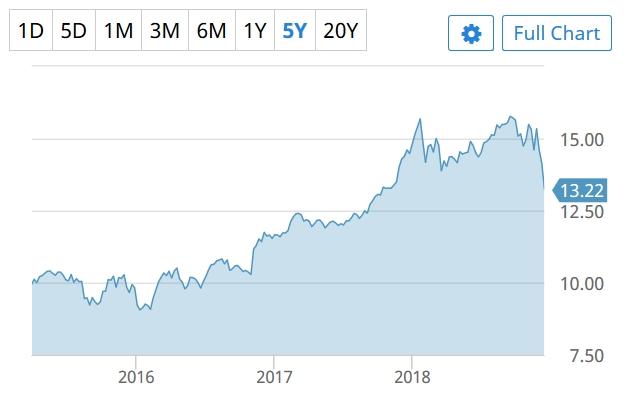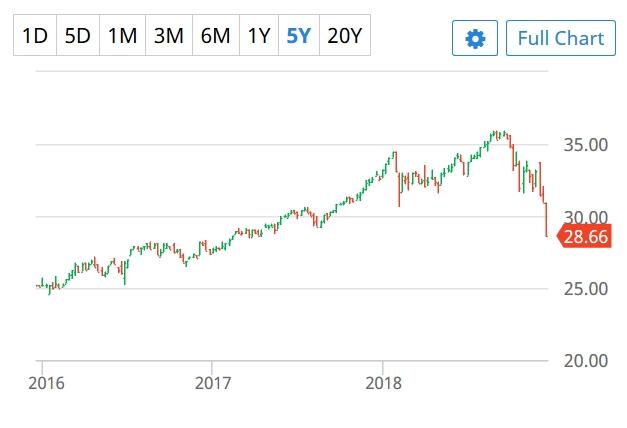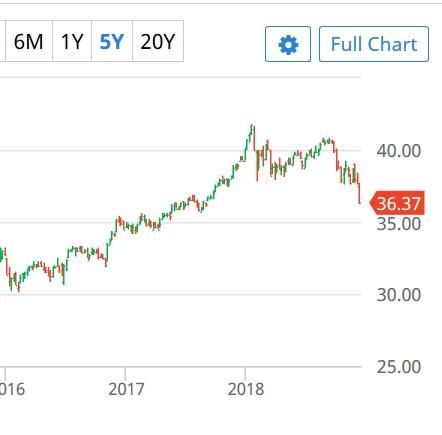Is There A Long/Short Fund Worth Buying?
Technically, it is correct that funds which sell secured puts can have a stock put to them at a lower price than it is today. That is a choice they make, but the name of the game for such funds is to collect the income, first and foremost.
Technically, it is also correct that a fund that owns some shares long and some shares short qualifies as a long-short fund. But if they do no fundamental analysis and are merely momentum players, it is absurd to think of them as providing protection in difficult times.
If a fund (by which I mean traditional open-end funds, closed-end funds and exchange-traded funds) simply buys whatever has the highest relative momentum (i.e., is most popular) and shorts whatever has the lowest (i.e., is already out of favor), then that fund is really no different than a long-only fund that ignores the weaker stocks.
What’s in a name? You will notice that, unlike a lot of funds that *call* themselves long-short funds but aren’t, GNNDX does not have those words in its name at all. Mssrs. Goldstein and Greenblatt have achieved their results by remaining 100% "net" long - achieving this, however, by being 190% long the cheapest large-cap US stocks based on their valuation research and 90% short the most expensive large-cap US stocks based on their valuation research. This is both an index fund and a long/short fund or, as they prefer to call it, an "Index Investment + Active Long/Short Overlay."

(Source: Barchart.com)
GNNDX has not escaped the fourth quarter decline, of course. It is down 12.5% since the September high for the year. Still, it may be worth considering for many investors. The reason fund managers believe this approach will be better for most investors, unlike traditional long/short funds, is that many investors don't take the time to educate themselves about value investing. So, if a long/short fund underperforms for a short period, they too often bail out, especially if their favorite benchmark is doing well when their fund isn't. Someone called it "short term-itis," and that's what it is. With GNNDX, the portfolio managers know they will stay close to their benchmark in good times (and have beaten it so far since inception) but will be able to protect assets better in bad times (since by the beginning of bad times, it is easy pickings to find expensive overpriced stocks to short).
You can’t judge a book by its cover and you can’t judge a long-short fund by its name.
For your further due diligence, you might want to consider one of the other Gotham funds, many of which have a variation on this same theme. If you’d rather do your due diligence at a one-stop shop, the Gotham Total Return Fund N (GTRNX) is a roll-up of many of these other funds. This fund invests the majority of its assets among mutual funds advised by Gotham (each an "underlying fund," and collectively, the "underlying funds"). Each of the underlying funds utilize a long/short equity strategy with varying levels of net exposure (long positions less short positions). All these funds have quite high expense ratios, but remember, all returns shown are net returns - after the payment of all fees and expenses.
There is no guarantee that in a down cycle those weaker momentum stocks will get weaker. In fact, the opposite is often true! When the FAANGs began their already hefty decline this year, it was the boring defensive stocks that many false “long-short” funds had shorted that *rose* rather than fall. Such funds got a double whammy in the fourth quarter - their shorts rose and their longs fell.
I suggest you study what a fund actually does rather than believe you are protecting yourself simply by buying something with the name “long-short” in its name. Let me provide a couple of interesting examples.
WisdomTree Dynamic Long/Short U.S. Equity ETF (DYLS) had a great run from its inception in December 2015 until early October 2018. In those 33 months, it rose just over 40% to $35 and change. Not bad for an ETF that owns both long and short positions, right?

(Source: Barchart.com)
Except that it does not. WisdomTree, at least for this fund, stays 100% long unless the portfolio manager decides to initiate a short position in an S&P 500 index option. I like the WisdomTree long-only approach which is mirrored here in DYLS: "The WisdomTree Dynamic Long U.S. Equity Index consists of approximately 100 U.S. large- and mid-capitalization stocks that meet Index eligibility requirements and have the best combined score based on fundamental growth and value signals. Stocks are weighted in the Long Equity Index according to their volatility characteristics."
In other words, this is a long-side fund that looks to buy lower-volatility companies that have what the fund believes to be better-than-average growth prospects. That makes it an “enhanced” rather than passive growth fund.
So, where is the short side? There isn’t one. Not unless and until the portfolio manager decides - and here’s the kicker - only at the first of every month, whether or not to hedge with a short index option. He didn’t do so in October. He didn’t do so in November even after the carnage of October. And judging by the price action in DYLS since, he didn’t do so in December either. If you had bought this fund because of WisdomTree’s well-earned reputation for enhanced fund investments, you would have risen with the market and ridden it right back down - in less than 3 months - to just 3½ dollars above where it was in December 2015.
It isn’t a long/short fund if it only goes short once a month (which I suppose they consider “discipline”), and only if the portfolio manager believes the coming month might be a rough one. I’m not blaming the portfolio manager here. That job is never easy - I know! But the problem with DYLS is structural, not personal. No one has a crystal ball, yet the manager only gets one shot once a month at being correct. At least if he could decide each Friday or some such, DYLS might qualify as a long/short fund in something beyond name only and still hew to a discipline that doesn’t change with every change in the breeze.
Another type of poseur long-short fund is the kind that does short some stocks but only as an adjunct to its long-only research. By that I mean they do not short because of a thorough review of a company’s balance sheet, income statement, cash flow, product or service, competitors, etc., but rather simply because they are an underperformer in terms of relative strength. This is precisely the same thing a long-only fund manager does: they review the 500 stocks in the S&P and decide for one set of factors or another - often simply relative momentum - that they will go long the top 150 and short the bottom 50.
Regardless of what the factor is or factors are, the mistake made here is that these securities are never static. The bottom 50 in factor "x" this week may be higher next week; the same is true of the top 150. There is no individual reason based on a company’s shortcomings to short them or buy them; they are simply part of a larger grouping.
First Trust, like WisdomTree, has some fine ETF offerings. I don’t think the First Trust Long/Short Equity ETF (FTLS) is one of them.
At least the top four holdings of DYLS were not “the usual suspects.” They are Cracker Barrel Old Country Store (NASDAQ:CBRL), VMware (NYSE:VMW), Macy’s (NYSE:M) and Mednax (NYSE:MD). Not so with FTLS. Its largest long-side holdings, as of December 20, are Berkshire Hathaway (BRK-A, BRK-B), Alphabet (GOOG, GOOGL), Apple (NASDAQ:AAPL) and Microsoft (NASDAQ:MSFT). Their largest short positions are Liberty Property Trust (NYSE:LPT), Madison Square Garden (NASDAQ:MSG), W.P. Carey (NYSE:WPC) and the iShares Russell 2000 ETF (NYSEARCA:IWM). With the exception of IWM (kudos, First Trust!) these others are also-rans in terms of recent momentum.
If you wanted to, you could construct a similar portfolio and save the fees; just buy what is running up and sell short what is walking sideways. That’s not to say that such funds might not provide value by saving you all those commissions and all that energy. I’m just saying a true long-short fund should identify reasons why an individual (rather than part of some group) company might deserve to be shorted while another might deserve to find a choice place in one’s long portfolio.
Regrettably, the results of selecting winners because they are currently winning and losers because they are currently losing does not give you much hope of avoiding market declines by buying their funds. I consider FTLS one of the better examples of this genre and have great respect for the original research First Trust is famous for. But the results of this particular approach are no better than those arrived at by using WisdomTree’s DYLS strategy:

(Source: Barchart.com)
Creating a chart beginning from the same date as the DYLS chart above, you see very similar results - a rise from 32 to 42 or so, and then a decline in February. The difference in the two charts would be the greater sideways action in FTLS for most of 2018 - maybe a bad thing from a short-term performance standpoint, but maybe also a sign the fund was doing more than merely picking the highest percentile to buy and shorting the lowest percentile (in relative momentum terms). Indeed, the decline for FTLS in the fourth quarter thus far was just 10%, while the S&P, as measured by SPY, was off 17%. It remains to be seen if FTLS might continue to offer at least something of a cushion in the event of a robust decline. If so, I will revisit the fund in a future article.
There are, of course, some funds that have performed well in both up and down markets. The Gotham Index Plus Fund N (GNNDX) is one I like and have written more extensively on here way back in March 2017. (My original article was about GINDX, the institutional variant. It carries a $250,000 minimum purchase, but that is waived by some brokerage firms and most firms if you are an RIA [Registered Investment Advisor] client.) At that time the fund had achieved annualized returns of 9.85%. 2018 helped raise those numbers considerably - until the fourth quarter. GNNDX is a “190/90” fund. That means the fund hews to an index but also goes long an additional 90% of the stocks in that index, hence the “190” of the equation. It also then shorts 90% of the total portfolio value, selecting companies that offer little in what they believe is true value. Managed by Joel Greenblatt and Robert Goldstein, their choices are heavily skewed to value investing.
Other funds in this arena that I suggest for your further due diligence include MFS Managed Wealth (multiple classes), AB Select US Long/Short Advisor (ASYLX), and Meeder Spectrum Fund - Retail Class (FLSPX).
I might be buying GNNDX or one of these others, but there are two other types of defensive funds or fund pairings that deserve their own article. Neither is called long-short but both may provide the returns you are seeking via a long-short fund purchase, but at a lower fee or for greater personal control. I actually prefer these two in many ways to funds organized as "long-short."
Since these deserve their own article, I’ll write one tomorrow. Look for it with the title of “Stealth Long-Short Funds: A Hedge By Any Other Name.”
These days, we need a growth component, a value component and a defensive hedge component in our portfolios. For an example you are welcome to enjoy a 100% Free Trial to take a look at my Growth & Value Portfolio here.
Disclosure: I have no positions in any stocks mentioned, but may initiate a long position in GNNDX over the next 72 hours.
Do your due diligence. If I can help, you are welcome to contact me ...
more


